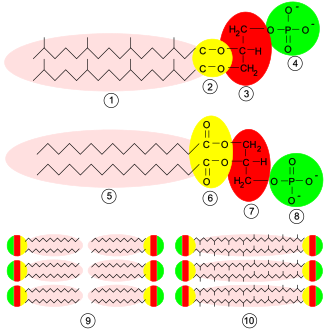Glycerophospholipid
An overview of glycerophospholipids in biological membranes
Glycerophospholipids[edit]

Glycerophospholipids are a class of lipids that are a major component of all cell membranes. They can form lipid bilayers because of their amphiphilic characteristic. The structure of glycerophospholipids consists of a glycerol backbone, two fatty acid tails, and a phosphate group attached to a polar head group.
Structure[edit]
Glycerophospholipids are composed of a glycerol molecule bonded to two fatty acids and a phosphate group. The fatty acids are hydrophobic, while the phosphate group is hydrophilic, allowing these molecules to form the lipid bilayer of cell membranes. The phosphate group can be further modified with molecules such as choline, ethanolamine, serine, or inositol, leading to different types of glycerophospholipids such as phosphatidylcholine, phosphatidylethanolamine, phosphatidylserine, and phosphatidylinositol.
Function[edit]
Glycerophospholipids play a crucial role in cell membrane structure and function. They provide the membrane with fluidity and flexibility, which is essential for the functioning of membrane proteins and the movement of substances across the membrane. They also participate in cell signaling processes and can be precursors for signaling molecules such as prostaglandins and leukotrienes.
Archaeal Membranes[edit]
Archaea are a domain of single-celled microorganisms that have distinct molecular characteristics separating them from bacteria and eukaryotes. One of the unique features of archaeal membranes is their lipid composition.
Unique Lipid Composition[edit]
Unlike the glycerophospholipids found in bacteria and eukaryotes, archaeal membranes contain ether lipids instead of ester lipids. The glycerol backbone in archaeal lipids is linked to isoprenoid chains via ether bonds, which are more stable than the ester bonds found in bacterial and eukaryotic lipids. This stability is thought to contribute to the ability of archaea to survive in extreme environments.
Function in Extreme Environments[edit]
The unique lipid composition of archaeal membranes allows them to maintain integrity and functionality in extreme conditions such as high temperatures, high salinity, and acidic environments. The ether bonds and branched isoprenoid chains provide increased membrane stability and reduced permeability, which are advantageous for survival in such conditions.
Related pages[edit]
Ad. Transform your life with W8MD's Budget GLP-1 injections from $75


W8MD offers a medical weight loss program to lose weight in Philadelphia. Our physician-supervised medical weight loss provides:
- Weight loss injections in NYC (generic and brand names):
- Zepbound / Mounjaro, Wegovy / Ozempic, Saxenda
- Most insurances accepted or discounted self-pay rates. We will obtain insurance prior authorizations if needed.
- Generic GLP1 weight loss injections from $75 for the starting dose.
- Also offer prescription weight loss medications including Phentermine, Qsymia, Diethylpropion, Contrave etc.
NYC weight loss doctor appointmentsNYC weight loss doctor appointments
Start your NYC weight loss journey today at our NYC medical weight loss and Philadelphia medical weight loss clinics.
- Call 718-946-5500 to lose weight in NYC or for medical weight loss in Philadelphia 215-676-2334.
- Tags:NYC medical weight loss, Philadelphia lose weight Zepbound NYC, Budget GLP1 weight loss injections, Wegovy Philadelphia, Wegovy NYC, Philadelphia medical weight loss, Brookly weight loss and Wegovy NYC
|
WikiMD's Wellness Encyclopedia |
| Let Food Be Thy Medicine Medicine Thy Food - Hippocrates |
Medical Disclaimer: WikiMD is not a substitute for professional medical advice. The information on WikiMD is provided as an information resource only, may be incorrect, outdated or misleading, and is not to be used or relied on for any diagnostic or treatment purposes. Please consult your health care provider before making any healthcare decisions or for guidance about a specific medical condition. WikiMD expressly disclaims responsibility, and shall have no liability, for any damages, loss, injury, or liability whatsoever suffered as a result of your reliance on the information contained in this site. By visiting this site you agree to the foregoing terms and conditions, which may from time to time be changed or supplemented by WikiMD. If you do not agree to the foregoing terms and conditions, you should not enter or use this site. See full disclaimer.
Credits:Most images are courtesy of Wikimedia commons, and templates, categories Wikipedia, licensed under CC BY SA or similar.
Translate this page: - East Asian
中文,
日本,
한국어,
South Asian
हिन्दी,
தமிழ்,
తెలుగు,
Urdu,
ಕನ್ನಡ,
Southeast Asian
Indonesian,
Vietnamese,
Thai,
မြန်မာဘာသာ,
বাংলা
European
español,
Deutsch,
français,
Greek,
português do Brasil,
polski,
română,
русский,
Nederlands,
norsk,
svenska,
suomi,
Italian
Middle Eastern & African
عربى,
Turkish,
Persian,
Hebrew,
Afrikaans,
isiZulu,
Kiswahili,
Other
Bulgarian,
Hungarian,
Czech,
Swedish,
മലയാളം,
मराठी,
ਪੰਜਾਬੀ,
ગુજરાતી,
Portuguese,
Ukrainian